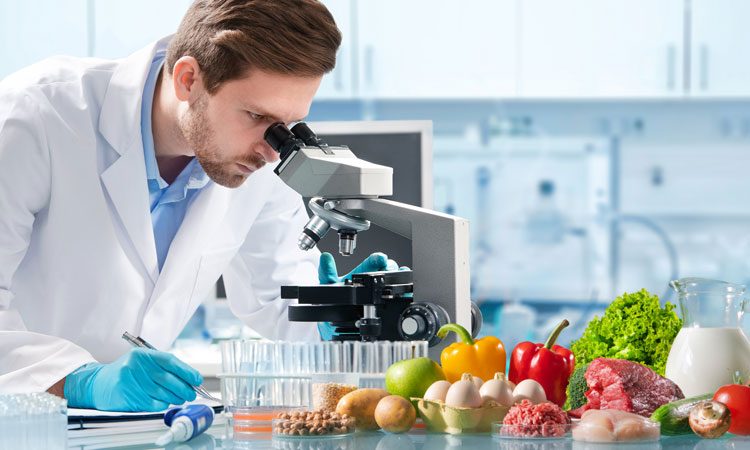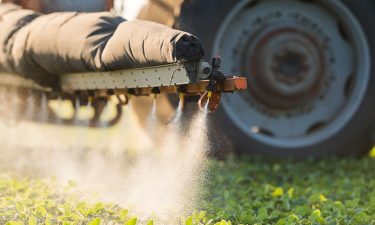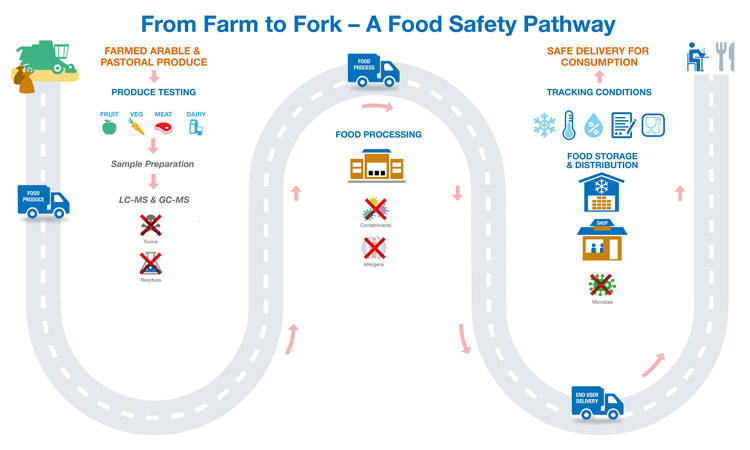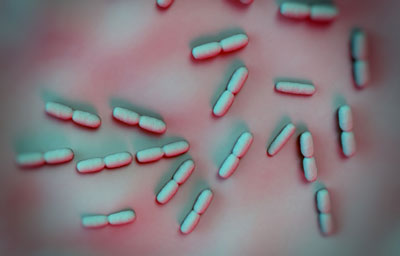From farm to fork: The journey through food safety
- Like
- Digg
- Del
- Tumblr
- VKontakte
- Buffer
- Love This
- Odnoklassniki
- Meneame
- Blogger
- Amazon
- Yahoo Mail
- Gmail
- AOL
- Newsvine
- HackerNews
- Evernote
- MySpace
- Mail.ru
- Viadeo
- Line
- Comments
- Yummly
- SMS
- Viber
- Telegram
- Subscribe
- Skype
- Facebook Messenger
- Kakao
- LiveJournal
- Yammer
- Edgar
- Fintel
- Mix
- Instapaper
- Copy Link
Posted: 30 July 2019 | Dr J J Lock | 1 comment
Food is being traded in huge amounts every day, with imports, exports and internal sales forming a complex and dynamic movement. When it comes to food safety every single item must be tracked and risk-managed along its journey from farm to fork.


Any lapse in food safety can have detrimental consequences on the consumer and have a negative financial impact on a company, not to mention significant repercussions on reputation. It stands to reason that food safety is preventative in nature rather than reactionary.
Food companies are required to have a safety plan in place to ensure that withdrawals from the market are minimised. The General Food Law, Regulation EC No 178/2002, dictates the general principles of food safety and food law, something food handling businesses must comply with in order to ensure that safe food is released to the market. The safety of food can be affected by a range of unwanted organisms or materials, such as residues, contaminants, toxins, microbes, and allergens.
According to a recent survey by the European Food Safety Authority the most concerning topics are the misuse of antibiotics, hormones and steroids in farm animals; pesticide residues in food; and food additives. Other concerns that have arisen are around the use of additives, food hygiene and food poisoning from bacteria.
Residual chemicals


To combat pests, agriculturalists use pesticides which can leave chemical residues.
Residues in food are already being addressed by legislation whereby Maximum Residue Levels (MRLs) dictate the legally permissible concentration of a compound in food or animal feed. MRLs are established following detailed studies on the active ingredients within a range of chemicals that come in contact with crops and livestock. Unfortunately, the requirement of a high-quality yield means that a group of one species, whether it be plant or animal, is spatially confined to one area. As a result, a ‘reservoir’ containing hosts is created and is therefore an inviting source of sustenance to pests and diseases. In addition, in terms of agriculture, a monospecific stand of a crop may be an ideal location for weed species where the opportunity for growth without competition arises.
In order to combat this problem, agriculturalists and horticulturalists use pesticides, herbicides, antibiotics and other supplements, which can leave chemical residues on or in produce. The analysis of these residues always starts with sample preparation and is proceeded by analysis in the form of Liquid Chromatography or Gas Chromatography and Mass Spectrometry. Sample preparation ensures that a sample is cleaned-up so that the analysis of the component of interest is not masked by interferences caused by other compounds, such as lipids, proteins and carbohydrates. This ensures accuracy and reproducibility, in addition to making it possible to detect low levels of an analyte.
Sample preparation techniques may involve Liquid-Liquid Extraction (LLE), Quick Easy, Cheap, Effective, Rugged, and Safe (QuEChERS) extraction and Solid Phase Extraction (SPE). Various products are available: QuEChERS Extraction and Clean-up Kits use organic solvent and salt solution to extract and partition the required analytes into solution; SPE Columns recover clean extracts and employ mixed-mode sorbents which exhibit a dual retention mechanism to significantly reduce the matrix components in the final extract; and Phase Separator Columns can quickly and easily separate aqueous and halogenated solvents, via a gravity-based filtration process.
Minimising the occurrence of contaminants
In a food manufacturing and packaging plant, it is absolutely vital to avoid contamination by a biological, physical or chemical contaminant. Biological contaminants are living organisms such as bacteria, moulds and fungi. Chemicals contaminants can originate from products used for cleaning and maintenance, in addition to residues as discussed above. Lastly, physical contamination can include anything from hair, glass, metal, plastic, dirt, and foreign organic matter. Cross-contamination can also be an issue where ingredients are unintentionally transferred into the wrong batch of food.
To help minimise the occurrence of contaminants in foodstuffs, the proper hardware must be employed throughout the manufacturing cycle. One key tool often used is a peristaltic pump which helps ensure safe and accurate transfer and dispensing of foodstuffs through a length of food-grade tubing. In the case of peristaltic pumps, the tubing, pump head and drive can be separated from one another, with the tube itself being the only item to come into contact with the food. What’s more, the tube can be disposed of and replaced relatively quickly which is beneficial to the operator as pump downtime is minimised. An added benefit is that much of the tubing doesn’t impart taste to the fluid being transferred and has excellent biocompatibility, low propensity for spallation and resistance to alkalis and acids.
Likewise, some peristaltic pumps have been engineered specifically for use in the laboratory and on the production floor. They can be used with virtually any fluid, even those with suspended solids, and can be applied to complex applications involving multiple products due to their capacity to undertake multichannel pumping. A range of tubing formulations and sizes enable operators to ensure they are meeting target flow rates and achieve the needed chemical compatibility. Furthermore, many drives are rated IP55 or better for easy wash-down, cleaning and sterilisation.


Limiting consumer contact with allergens or foodborne disease
In 1906 Clemens von Pirquet and Béla Schick coined the term ‘allergy’, meaning other (allos) reaction (ergon). An allergic reaction is a hypersensitivity to a certain ingredient which leads to an Immunoglobulin-E (IgE) or a non-IgE mediated immune response. The former can have greater consequences than the latter, however, either way, they both impact quality of life.
Over 100 years later allergies are still a problem for many people, where consumption of products contaminated with allergens can lead to serious consequences. With the introduction of ‘Natasha’s Law’, this year, it is a requirement for pre-packaged food to be labelled with a full list of ingredients so that people have full visibility over what they are consuming, and as a result can make an informed choice. As reported by New Food Magazine on the 25 June 2019, this legislation will come into effect by mid-2021 and will positively impact individuals that suffer from both allergies and intolerances.
One of the most well-known ingredients capable of inducing an allergic reaction is the peanut (Arachis hypogaea). 1 in 100 people in the UK have an allergy to peanuts; symptoms can be severe and include anaphylaxis which can be life-threatening. When detecting allergens in food items the target constituent may be at a low concentration, and so very specific protocols must be followed in order to test for their presence. Tests can include: the protein-based Enzyme Linked Immunosorbent Assay (ELISA); DNA-based Polymerase Chain Reaction (PCR); and the molecular mass detecting Liquid Chromatography Mass Spectrometry/Mass Spectrometry (LC-MS/MS).
PCR was invented by Kary Banks Mullis in 1983, and to this day is commonly used as a method of detection, whereby the gene that codes the allergen is amplified and detected. Indeed, using DNA detection kits, together with real-time thermal cycler, allows for successful detection of allergen DNA extracted from products that have been subject to mechanical processing and heat treatment. These kits show a high specificity for one allergen over another with no cross-reactivity to other substances present in the samples, and so it is ideal for producing accurate results.


Listeria can survive and grow in a range of conditions.
In addition to detection of allergens, PCR can be used to detect foodborne pathogens. Much like an allergen, pathogenic microorganisms and their metabolic waste products can be deleterious to health to the point of being fatal. Food is an excellent breeding ground for microorganisms and can become contaminated with their toxic metabolites which renders the food inedible and unsafe. A recent and tragic contamination of hospital food with Listeria monocytogenes is an unfortunate example of this. As reported by The Observer on the 15 June 2019, this bacterium can contaminate food readily due to its presence in the environment and can go undetected due to its long incubation period (70 days).
A pathogen like L. monocytogenes can survive and grow in a broad range of conditions and has been previously referred to by Gandi and Chikindas (2007) as a ‘foodborne pathogen that knows how to survive’. The survival and growth of pathogens in food can be greatly influenced by the availability of nutrients, temperature, pH, moisture, and moisture levels. It is therefore important that these are monitored during food production so that conditions do not become conducive to pathogen growth. Temperature, pH and salinity can be tested easily with instruments which are designed for monitoring conditions in food, as recommended by food standards.
Keeping conditions stable
Temperature and humidity should not only be monitored during processing and pasteurisation, but also during storage and distribution as well. Time and temperature are limiting factors when it comes to food safety. Food should be kept at temperatures that are outside of the normal temperature range preferred by microbes and transported within a period of time that ensures food is safe upon arrival at its destination. Ideally, all products should be fully traceable and backed up by an auditable log for every step of the manufacturing and distribution process.
When continuous temperature and humidity monitoring is needed, data loggers provide a more cost-effective option than hard-wired temperature sensors which can be time-consuming and expensive. These instruments are especially advantageous when visibility over product is restricted as they can register the critical parameters of specimens during transit, making cold chain management worry-free, allowing continuous monitoring and thus filling in the unknowns between destinations.
To conclude
From the 2019 Eurobarometer Survey, conducted by the European Food Safety Authority, the issues at the heart of food purchasing choices are: the origin of the food; cost; food safety; taste; and nutrition. It is clear that chemical residues are a top concern for people, in addition to the risk of allergens and the likelihood of food poisoning. It is therefore important that food is screened for deleterious and unwanted organisms or materials in order to maintain public safety.
Biography
JULIA LOCK is a Content Specialist at Cole-Parmer, responsible for delivering accurate application-based information about a broad range of products. Prior to joining the company, Julia spent several years in academia, in the lab, and out in the field undertaking plant pathology studies, after which she obtained a doctorate in 2018.
Sources
- European Commission (2017) Ensuring Food is Safe – The Veterinary and Phytosanitary System of the European Union Explained, Publications Office, Luxembourg.
- Gandhi, M. and Chikindas, M.L. (2007) Listeria: a foodborne pathogen that knows how to survive. International journal of food microbiology, 113(1): 1-15.
- European Food Safety Authority (2019) Pesticide residues in food: what’s the picture in the EU? [accessed online: 08.07.19] https://www.efsa.europa.eu/en/press/news/190626
- European Food Safety Authority (2019) ‘Food safety, everybody’s business’ – the first World Food Safety Day 2019 [accessed online: 08.07.19] https://www.efsa.europa.eu/en/press/news/190607-0
- European Food Safety Authority (2019) Europeans on today’s food issues: new EU-wide survey comes out on first World Food Safety Day [accessed online: 08.07.19] https://www.efsa.europa.eu/en/press/news/190607
Related topics
Allergens, Contaminants, Equipment, Food Safety, Pesticides, Processing, Product Development, Pumps & Valves, Refrigeration and freezing, Research & development, Technology & Innovation, Temperature control










it was a very good article. read with pleasure. thank u .